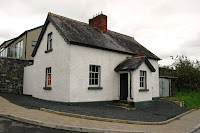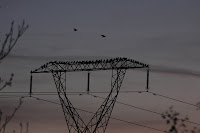When we visited UK in 2007 we visited Charley Hall in Leicestershire that the Waldrons had taken off them by investors in the late 1500s. Dromellan Castle was allotted to them by King James I in 1609. The people in the Waldron estates here in Co Roscommon had not heard of it.
Off to the town of Cavan we went, in the drizzle and light rain. First we found an internet Cafe to clear our emails, then we paid a visit to the Cavan library. Cavan is pronounced like 'Kevin', not like 'Car-Van'. The nice lady in the genealogy section finished a tedious phone call with someone who had not done any groundwork and wanted all the answers. She was a bit surprised at our enquiry, then typed in a few things and said that Dromellan had been re-named the Farnham Estate and was now a large hotel! She gave us a map and book, and now we have pieced together the following:
The story begins with Henry Waldron, Esq born abour 1450, who developed a brewery 'without Newgate' in London, and with his money bought large estates in Leicestershire over 300 years,
In 1609, his gt-gt-grandson Sir Richard Waldron left Charley Hall (after the investors took it off him in court) and settled at Dromellan Castle, Co.Cavan, Ireland, an estate of 2000 acres allotted by King James I. There was also a manor at Dromhill, the total estates being about 7000 acres. In 1664, due to gambling debts, his son, Sir Thomas Waldron sold Dromellan Castle to Bishop Maxwell whose his eldest son John Maxwell took over control of the estate in 1672 when the Bishop died. It seems that the original house was rebuilt in the 1700-1800 period by the Maxwells. In 1756 John Maxwell was awarded the title Baron Farnham of Farnham, and the property has been known since then as the Farnham Estate. Parts of the manor house had dry rot and were demolished in 1961 and the building seen today is about 1/3 of the original house. It is operated as Radison Hotel, www.farnhamestate.com





We had a look at 'our estate', then with approval of the hotel desk lady took a walk through the manor house and had a look at the gatehouse and the remaining buildings.


We thought we would be quite at home with shooting a few pheasants for dinner on our 2000 acres, instructing the staff and gardeners what was required and entertaining a few regal visitors.
On the way home we visited the Cavan County Museum at Ballyjamesduff, where they hold many artifacts and paintings from Farnham, nothing as old as the Waldron period, however.
Unfortunately the Waldron story is one of losing major investments by gambling and we wondered if they were not encouraged to leave for Australia in 1831, the trip leading to Illawarra in NSW and the New Zealand branch of the family. More recently, in the early 1900's, Doug's gt-grandfather achieved infamy by painting a horse another colour in Auckland (making a fast horse look like a slow horse). The genes had obviously been passed on!

On another subject entirely, we have been amused to see all the crows flying to their night roost on top of this transmission tower! Crows are the most common bird here.
2 comments:
Nothing lasts for ever even wealth in families. Great article!
Some of the facts stated here are not strictly accurate...Sir Richard Waldram having been gifted Dromellan Castle and Estate found it a difficult place to live(the land was primative; the locals not happy with what they saw as an invasion of the English aristocracy - this is recorded under The Plantation of Ulster)
Sir Richard eventually returned to Charley Hall where he subsequently died.
Charles Hall was sold later when son Sir Thomas inherited it. He married Lady Elizabeth Beaumont but was forced to sell Charley to settle gambling debts.
Post a Comment